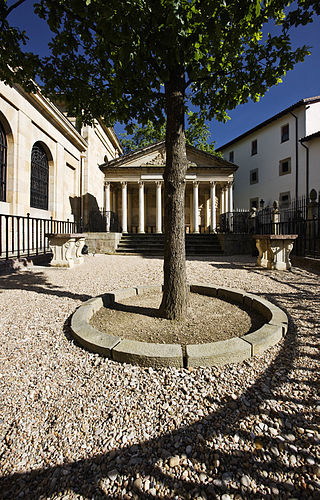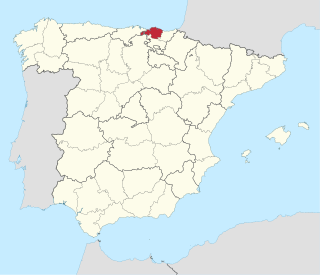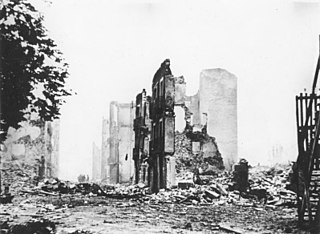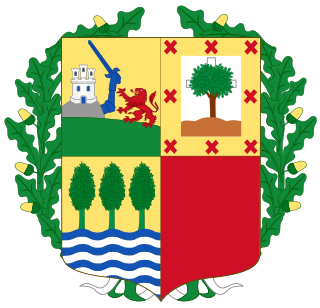Related Research Articles

Guernica, officially Gernika in Basque, is a town in the province of Biscay, in the Autonomous Community of the Basque Country, Spain. The town of Guernica is one part of the municipality of Gernika-Lumo, whose population is 16,224 as of 2009.

Biscay is a province of Spain and a historical territory of the Basque Country, heir of the ancient Lordship of Biscay, lying on the south shore of the eponymous bay. The capital and largest city is Bilbao.

The Condor Legion was a unit of military personnel from the air force and army of Nazi Germany’s Wehrmacht which served with the Nationalist faction during the Spanish Civil War. The Condor Legion developed methods of strategic bombing that were used widely during the Second World War. The bombing of Guernica was the most infamous operation by the Condor Legion. Hugo Sperrle commanded the unit's aircraft formations and Wilhelm Ritter von Thoma commanded the ground element.

On 26 April 1937, the Basque town of Guernica was aerial bombed during the Spanish Civil War. It was carried out at the behest of Francisco Franco's rebel Nationalist faction by its allies, the Nazi German Luftwaffe's Condor Legion and the Fascist Italian Aviazione Legionaria, under the code name Operation Rügen. The town was being used as a communications centre by Republican forces just behind the front line, and the raid was intended to destroy bridges and roads. The operation opened the way to Franco's capture of Bilbao and his victory in northern Spain.

Gernikako Arbola is an oak tree that symbolizes traditional freedoms for the Biscayan people, and by extension for the Basque people as a whole. The Lords of Biscay swore to respect the Biscayan liberties under it, and the modern Lehendakari of the Basque Country swears his charge there.

Guernica is a large 1937 oil painting by Spanish artist Pablo Picasso. It is one of his best-known works, regarded by many art critics as the most moving and powerful anti-war painting in history. It is exhibited in the Museo Reina Sofía in Madrid.
In 1937, the Nationalists, under the leadership of Francisco Franco began to establish their dominance. An important element of support was their greater access to foreign aid, with their German and Italian allies helping considerably. This came just as the French ceased aid to the Republicans, who continued, however, to be able to buy arms from the Soviet Union. The Republican side suffered from serious divisions among the various communist and anarchist groupings within it, and the communists undermined much of the anarchists' organisation.

George Lowther Steer was a South African-born British journalist, author and war correspondent who reported on wars preceding World War II, especially the Second Italo-Abyssinian War and the Spanish Civil War. During those wars he was employed by The Times, and his eye-witness reports did much to alert western nations of war crimes committed by the Italians in Ethiopia and by the Germans in Spain, although little was done to prevent them by the League of Nations, and his 1937 exclusive on the bombing of Guernica inspired Pablo Picasso to paint his anti-war masterpiece, Guernica. He returned to Ethiopia after the world war started and helped the campaign defeat the Italians and restore Hailie Selassie to the throne.
Guernica is a Spanish Basque town and historical capital of Biscay.

The Statute of Autonomy of the Basque Country of 1979, widely known as the Statute of Gernika, is the legal document organizing the political system of the Autonomous Community of the Basque Country' which includes the historical territories of Alava, Biscay and Gipuzkoa. It forms the region into one of the autonomous communities envisioned in the Spanish Constitution of 1978. The Statute was named "Statute of Gernika" after the city of Gernika, where its final form was approved on 29 December 1978. It was ratified by referendum on 25 October 1979, despite the abstention of more than 40% of the electorate. The statute was accepted by the lower house of the Spanish Parliament on November 29 and the Spanish Senate on December 12.

The Weeping Woman is a series of oil on canvas paintings by Pablo Picasso, the last of which was created in late 1937. The paintings depict Dora Maar, Picasso's mistress and muse. The Weeping Woman paintings were produced by Picasso in response to the bombing of Guernica in the Spanish Civil War and are closely associated with the iconography in his painting Guernica. Picasso was intrigued with the subject of the weeping woman, and revisited the theme numerous times that year. The last version, created on 26 October 1937, was the most elaborate of the series, and has been housed in the collection of the Tate Modern in London since 1987. Another Weeping Woman painting created on 18 October 1937 is housed at the National Gallery of Victoria and was involved in a high-profile political art theft.

The campaign of Gipuzkoa was part of the Spanish Civil War, where the Nationalist Army conquered the northern province of Gipuzkoa, held by the Republic.

The Spanish Civil War was fought from 1936 to 1939 between the Republicans and the Nationalists. Republicans were loyal to the left-leaning Popular Front government of the Second Spanish Republic, and consisted of various socialist, communist, separatist, anarchist, and republican parties, some of which had opposed the government in the pre-war period. The opposing Nationalists were an alliance of Falangists, monarchists, conservatives, and traditionalists led by a military junta among whom General Francisco Franco quickly achieved a preponderant role. Due to the international political climate at the time, the war had many facets and was variously viewed as class struggle, a religious struggle, a struggle between dictatorship and republican democracy, between revolution and counterrevolution, and between fascism and communism. According to Claude Bowers, U.S. ambassador to Spain during the war, it was the "dress rehearsal" for World War II. The Nationalists won the war, which ended in early 1939, and ruled Spain until Franco's death in November 1975.

As the Spanish Civil War proceeded on the Northern front, the Spanish Republican authorities arranged the evacuation of children, some of whom had insufficient documentation to enable their repatriation.
Gernika is Francisco Escudero's second opera, written in 1985. The libretto was written by Escudero with the assistance of Carmelo Iturria and Augustin Zubikarai, and based on an idea for a plot by Luis Iriondo.

The Bombing of Durango took place on 31 March 1937, during the Spanish Civil War. On 31 March 1937 the Nationalists started their offensive against the Republican held province of Biscay. As part of the offensive the Aviazione Legionaria and the Legion Condor bombed Durango, a town of 10,000 inhabitants that was also a key road and railway junction behind the frontline. Around 250 people are believed to have died in the bombing.

"Gernikako Arbola" is the title of a song in bertso form presented both in Madrid (1853) and by the shrine of Saint Anthony at Urkiola (1854) by the Basque bard José María Iparraguirre, celebrating the Tree of Gernika and the Basque liberties. The song is the unofficial anthem of the Basques, but only the first stanza is sung as the Basque anthem. In 2007, the General Assembly of Biscay declared it the district's official anthem.

Guernica is a 2016 Spanish-British-American war romance drama film directed by Koldo Serra, starring James D'Arcy, María Valverde and Jack Davenport. It is the first feature film made about the 1937 bombing of Guernica.
The Spanish Cockpit is a personal account of the Spanish Civil War written by Franz Borkenau and published in late 1937. It was based on his two wartime visits to Spain in August 1936 and January 1937, visiting Barcelona, Madrid, Toledo, Valencia, and the Aragon and Andalusia fronts. The book brought Borkenau international fame. After writing a positive review of the book, describing the book as the best on the civil war, George Orwell became a personal friend of the author's and the two remained politically close.
References
- 1 2 Woolbert 1938, p. 184–185.
- ↑ Cunningham 2009.
- ↑ Evans 2005.
- ↑ Black 2008, p. 228–229.